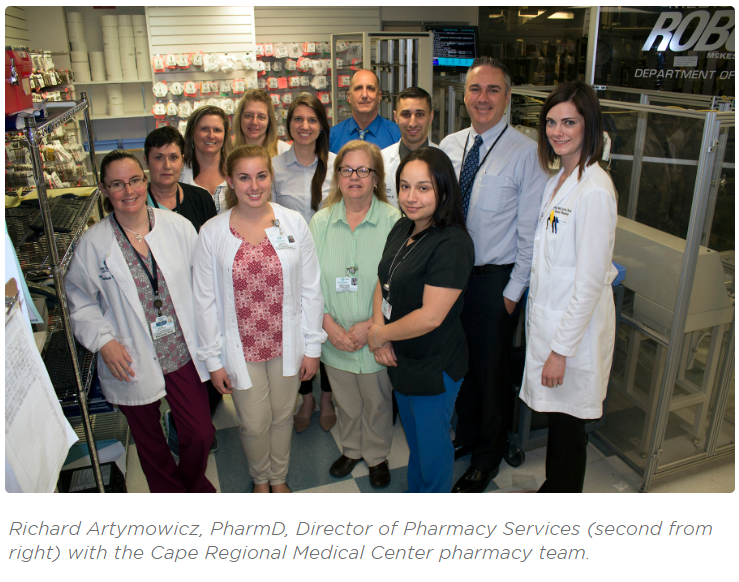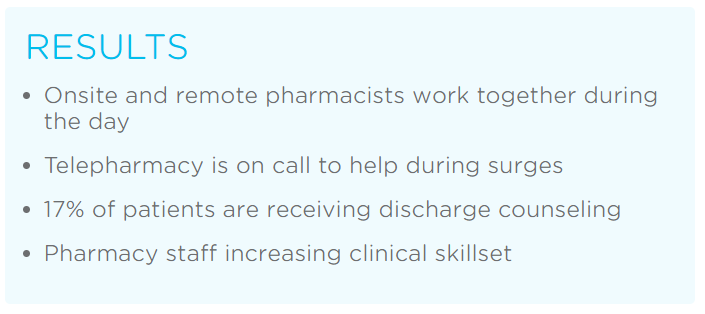Cape Regional Medical Center | Cape May Court House, New Jersey

In 2015, the decision was made to decentralize their pharmacy operations into a unit-based model to focus on achieving more of their patient-centric goals. With one pharmacist managing the central pharmacy, the remaining staff were assigned to specific areas in the facility to work with care teams, helping improve patient outcomes, HCAHPS scores and provide an opportunity for pharmacy residency programs.
Learn how CRMC used telepharmacy to:
-Fill a gap in pharmacy coverage created by new clinical goals
-Review medication orders from the ED
-Supplement their onsite team during surges in medication orders
-Free up onsite pharmacists to deliver discharge counseling for 17% of patients and growing
-Enable onsite team to grow their skills and extend their career paths

Addressing a gap in coverage: the challenge
It was about that same time in 2015 that Richard was introduced to PipelineRx and learned how telepharmacy was helping hospitals supplement their pharmacy staff. While the proposition sounded good, in his mind he already had a 24/7 staff and didn’t consider it something worth pursuing.
However, as they began to focus on their next challenge, reducing readmissions, they needed the team do more discharge counseling. To do this, the staff had to rearrange their schedules, causing a gap in coverage. “We were missing four hours of coverage during the swing shift,” said Richard. “However, the order volume during those four hours is highly variable, and unfortunately unpredictable, so adding on-site resources daily wouldn’t always be cost-effective.”

Rethinking the options: the solution
Remembering the conversation with PipelineRx, he gave them a call. “Telepharmacy began to look like a viable option to handle med order verification which would free up more time for our onsite staff,” said Richard. “With PipelineRx already New Jersey State Board of Pharmacy approved, I was able to move quickly.”
With one call, he was on his way to using PipelineRx telepharmacy services to complement his staffing needs. The approach would be seamless to the hospital nursing staff who would continue to have the onsite pharmacist as their primary point of contact. Furthermore, the per order pricing structure provided the budgetary flexibility and customization that was needed.
Lessons learned: challenges with change
Despite adoption by the clinical team, the pharmacy staff had concerns about utilization of telepharmacy. “The team prides themselves on high-quality care for patients,” said Richard. “There was some unease surrounding the qualifications and competencies of remote pharmacists they hadn’t met or worked with.”
To help address this, the PipelineRx account management team met with the CRMC pharmacists and had an open discussion about the telepharmacists’ credentials and processes. This provided the team with greater confidence and they came to understand that working with the PipelineRx pharmacists would require the same learning curve as hiring new staff.
By increasing communication, the pharmacy team ultimately worked with PipelineRx pharmacists just as they would have if they had hired onsite staff. “I realized that most clients work with their telepharmacists when there was nobody else around,” said Richard. “In our case, we had to learn to work together.”

A well-oiled workflow: the results
At first, PipelineRx telepharmacists were reviewing a relatively small number of orders, so to clarify roles and better balance the workload the two teams worked together to divide the order queue. The onsite team took inpatient orders while the telepharmacy team managed ED orders. Additionally, when workflows shift and surges occur, CRMC pharmacists make a quick call to their PipelineRx team to have them start taking inpatient orders as well, which helps keep turnaround times within the target range.
The CRMC team learned that their dedicated PipelineRx team was a great complement to their staff. With the increased coverage for medication order review, onsite pharmacists were able to do more discharge counseling, initially reaching 17% of patients with a goal of increasing the rate to 30% by the end of the year.

This post is related to:
Telepharmacy, Remote Order Entry